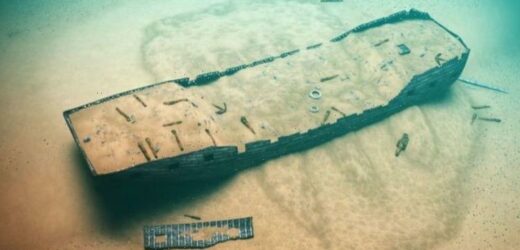Japan: Volcano eruptions cause WWII shipwrecks to surface
We use your sign-up to provide content in ways you’ve consented to and to improve our understanding of you. This may include adverts from us and 3rd parties based on our understanding. You can unsubscribe at any time. More info
The Goodwin Sands is a 16km-long (10 miles) sandbank lying around 10km (six miles) off the coast of East Kent. The area consists of a layer approximately 20 metres (82ft) deep of sand, resting on the chalk bedrock. The Goodwins, as they are affectionately known, are a picturesque sight when looking out to sea from the likes of Deal, Dover and Ramsgate on a clear day. But, for ships, they have been a deadly hazard since seafaring began.
Dubbed the “ship swallower” by maritime archaeologist and diver Dan Pascoe, there are around 2,000 known shipwrecks on the Goodwins, with the true number thought to be well above 3,500.
The Goodwins lie in one of the busiest shipping lanes in the world, and some say as many as 50,000 have lost their lives there.
Tides and currents are constantly moving the sand, and the glutinous nature of the Goodwins ensures ships that hit the sand sink to a watery grave.
The ship generally hits the top of the Goodwins, and the weight of the ship sees it sink into the sand until it hits the bedrock, where it may remain uncovered for hundreds of years.
The first recorded wrecking was way back in 1298.


The first lightship was positioned on the eastern edge of the Goodwins in 1795, and a vessel still remains in place today.
Prior to this, ships were reliant on the North and South Foreland lighthouses situated just north of Broadstairs and at St Margaret’s Bay, just outside Dover, respectively.
The Great Storm of 1703 was one of the worst storms to hit British shores in history. Ships were blown hundreds of miles off course, and 130 ships and 1,200 sailors were lost in one single night.
Four of those were Royal Navy warships — HMS Northumberland, Mary, Restoration and Stirling Castle.
All four are now listed as Protected Wrecks, the marine equivalent of Listed Buildings.

The Stirling Castle was commissioned in 1674 after Samuel Pepys convinced King Charles II to begin the construction of 30 ships to improve naval performance.
It was the night of November 27, 1703, where she met her fate.
Anchored in The Downs with over 200 other ships, the stretch between the Goodwins and the shore, she is believed to have been overwhelmed by the waves and sank.
In 1979, recreational divers found the wreck after movement of the surrounding sand. She was in remarkable condition.
Fiona Punter, trustee of the Goodwin Sands Conservation Trust, told Express.co.uk: “The Stirling Castle was found at the time of the Mary Rose in Portsmouth.
DON’T MISS:
Archaeologists stunned by discovery that ‘revolutionised Bible’ [INSIGHT]
Archaeology: Titanic ‘rapidly deteriorating’ amid new footage [EXPERT]
Archaeologists discovered more than 300 skeletons in ‘scene of horror’ [QUOTES]

“The Stirling Castle was in better repair than the Mary Rose. You could walk down the steps into it. It was a perfect ship on the seafloor.
“What happened, the Government at the time, everyone was so into the Mary Rose and that got all the publicity, then the sand moved and it covered the Stirling Castle up.
“Now, bits of it are showing and the sand has crushed it. It’s still there, but in pieces as opposed to being the whole ship.”
Among the roughly 300 artefacts retrieved include a Rupertinoe gun complete with carriage and wheels, a ship’s bell, crockery and a well-preserved basket full of what was believed to be dried raisins on a vine, assumed to be grapes.
These provided evidence of the Stirling Castle’s recent return from Portugal.

Owing to movement of the sand, the Stirling Castle now lies in about 15 metres of water. However, as the sand moves, other impressive wrecks are uncovered.
Mr Pascoe told Express.co.uk that the Stirling Castle’s sister ship, the Northumberland, is reemerging: “The Northumberland is on the edge of one of the major Goodwin sandbanks.
“Along that edge you’ve got a series of large fingers of sand that are moving in the direction away from the shipwreck right now.
“It’s exposing more of the ship each year that we go back to dive it. You can see cannons with carriages on, you can see parts of the ship’s structure coming out, you can see swords and muskets.
“You’ve got boxes and chests. It’s pretty amazing what’s coming out of the sand at the moment, it’s quite a critical point.”
He said there is a “cycle” going on, in which one wreck is coming out of the sand whilst another is being buried.
The density of wrecks around the Goodwin Sands is the highest in European waters, and quite possibly the world.
The Goodwin Sands Conservation Trust are fighting to prevent further dredging at the site, as even the latest technology cannot show the sheer number of wrecks hidden.
Year on year, more discoveries are being made. Ms Punter told Express.co.uk a local diver returned with video footage of a World War Two bomber that nobody had previously known about.
She said: “That was actually on the line of the dredge zone. It was in the original dredge zone but they modified it.
“If they hadn’t modified it, that bomber would go. They’d dredge it up.”
Source: Read Full Article


